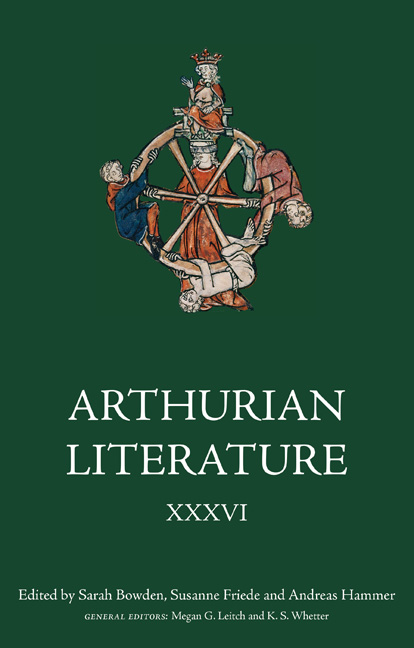Book contents
- Frontmatter
- Contents
- General Editors’ Preface
- List of Contributors
- Introduction: Sacred Space and Place in Arthurian Romance
- 1 The Church and the Otherworld: Sacred Spaces in the Matière de Bretagne and Medieval Ireland
- 2 Sacred Spaces: the Syntagmatic and Paradigmatic Construction of Narrated Space in Chrétien’s Conte du Graal
- 3 Perceiving the Way: Sacred Spaces and Imaginary Pilgrimage in the Vulgate Cycle Queste del Saint Graal and Thomas Malory’s ‘Tale of the Sankgreal’
- 4 Affirming Absence and Embracing Nothing: on the Paradoxical Place of Heterosexual Sex in Medieval French Verse Romance
- 5 Spaces of Remorse: Penitential Allusions in Iwein
- 6 The Spatial Narratives of Salvation and Damnation in Wigalois and the Prose Lancelot
- 7 ‘Fantoum and Fayryȝe’: Visions of the End of Arthurian Britain
- 8 The Tomb of the Kings: Imperial Space in Arthur’s Camelot
- Contents of Previous Volumes: Details of Earlier Titles are Available from the Publishers
3 - Perceiving the Way: Sacred Spaces and Imaginary Pilgrimage in the Vulgate Cycle Queste del Saint Graal and Thomas Malory’s ‘Tale of the Sankgreal’
Published online by Cambridge University Press: 17 April 2021
- Frontmatter
- Contents
- General Editors’ Preface
- List of Contributors
- Introduction: Sacred Space and Place in Arthurian Romance
- 1 The Church and the Otherworld: Sacred Spaces in the Matière de Bretagne and Medieval Ireland
- 2 Sacred Spaces: the Syntagmatic and Paradigmatic Construction of Narrated Space in Chrétien’s Conte du Graal
- 3 Perceiving the Way: Sacred Spaces and Imaginary Pilgrimage in the Vulgate Cycle Queste del Saint Graal and Thomas Malory’s ‘Tale of the Sankgreal’
- 4 Affirming Absence and Embracing Nothing: on the Paradoxical Place of Heterosexual Sex in Medieval French Verse Romance
- 5 Spaces of Remorse: Penitential Allusions in Iwein
- 6 The Spatial Narratives of Salvation and Damnation in Wigalois and the Prose Lancelot
- 7 ‘Fantoum and Fayryȝe’: Visions of the End of Arthurian Britain
- 8 The Tomb of the Kings: Imperial Space in Arthur’s Camelot
- Contents of Previous Volumes: Details of Earlier Titles are Available from the Publishers
Summary
In the Vulgate Cycle Queste del Saint Graal, the Grail quest opens with a transition between landscapes. As the knights leave the castle of Vagan, we hear that they ‘departirent maintenant li uns de l’autre einsi come il l’avoient porparlé, et se mistrent en la forest li uns ça et li autres la, la ou il la voient plus espesse, en tous les leus ou il trovoient ne voie ne sentier’ [‘dispersed, as they had decided previously, and entered the forest at those points where they found it to be thickest, following no path or trail’]. The forest outside of the castle of Vagan represents a point of transition between two different types of spatial framework: stepping away from the path, leaving the well-worn tracks of Arthurian romance behind, signifies a move into the symbolic world of the Grail. The knights are no longer travelling through a known landscape traversed by their predecessors and in which, at any point, they may encounter a friend or an enemy, but instead will be entering a new world in which each knight is the first voyager and every journey is unique. In ‘The Tale of the Sankgreal’ Thomas Malory omits the mention of the forest and instead further emphasizes the importance of individual choice to each knight's journey, writing that ‘on the morne they were all accorded that they sholde departe everych from othir. And on the morne they departed with wepyng chere, and than every knyght toke the way that hym lyked beste’ (677.23–26). In both texts, although the geographical features that form each knight's quest physically resemble some of the landscapes of more secular Arthurian romance, the spatial framework that he occupies becomes a physical manifestation of the inner journey of spiritual improvement that he must make. Thus, each knight's spiritual state takes precedence over the actual spaces through which he rides and determines the physical journey that he experiences. In the world of the Grail, interior becomes exterior; the private relationship that each knight has with his God is projected onto the Arthurian landscape.
This interaction between secular and spiritual spaces and spatiality within the Grail quest reflects the fusion of secular and spiritual priorities fundamental to medieval concepts of chivalry. Maurice Keen defines medieval chivalry ‘as an ethos in which martial, aristocratic and Christian elements are fused together’.
- Type
- Chapter
- Information
- Arthurian Literature XXXVISacred Space and Place in Arthurian Romance, pp. 57 - 78Publisher: Boydell & BrewerPrint publication year: 2021



